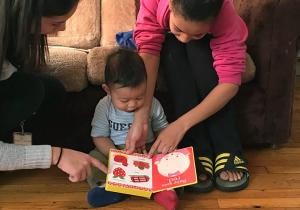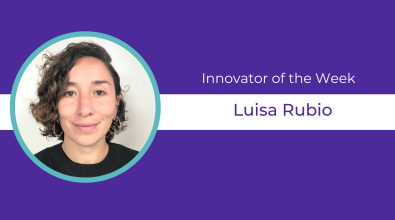New evidence helps more cities adopt Providence Talks model

A Providence, R.I., program aimed at increasing the number of words young children hear from adults is producing gains in language development.
Four years ago, Providence, R.I., changed the conversation about conversation itself — particularly as it pertains to children from birth to age 3.
City leaders designed a program aimed at closing what’s known as the “word gap.” The term refers to the fact that children in low-income households hear fewer spoken words each day than peers from higher-income households — 30 million fewer by the time they reach kindergarten. Research shows that robust interaction with language is crucial for children’s vocabulary building, brain development, and school readiness.
Now, a new study from Brown University shows that Providence’s strategies for addressing this problem are working. At the same time, communities across the U.S. are beginning to replicate and adapt parts of the Providence model.
The core of the program, known as Providence Talks, is data collected via a recording device that children wear. Like a pedometer counts steps, the device tallies the number of words children hear each day, as well as turns in the conversation between adult and child. Parents and caregivers get coaching on the importance of speaking more with the children, and how to use the recording device to track their progress.
Providence has impacted more than 2,500 children through three separate program models. In the first, coaches meet one-on-one with families in their homes over an eight-month period. The second is based around playgroup sessions, with a facilitator engaging a number of families at the same time. The third is a professional development model targeted at staff working at childcare centers. Experimentation with these models was funded by Bloomberg Philanthropies — Providence won the $5 million grand prize in the 2013 Mayors Challenge.
The Brown study concluded that “Providence Talks constitutes a promising strategy to disrupt the status quo to advance early learning for all children.” Looking specifically at the home-visiting and playgroup models, the study found children made significant gains overall, not only in the number of words and conversational turns they heard but also in language development. The largest gains came among children who started out the furthest behind.
For most of the children Providence Talks has reached, school remains a ways off: Large numbers of them won’t begin entering kindergarten until the fall of 2019. But, so far, the results look good. “The Providence Talks intervention,” the study found, “is having a strong impact on the families it’s serving.”
Replication, not duplication
This research comes at a time when a growing number of communities are tackling the word gap. Some are seeking advice directly from Providence, whose team has fielded numerous phone calls and site visits, shared their curriculum and operations manual, and published a playbook for how to replicate the model.
Cities also are taking inspiration from Thirty Million Words, a University of Chicago initiative founded by Dana Suskind, whose book popularized the word-gap problem. And they’re hearing about it from LENA, the Colorado-based nonprofit that makes the voice recording devices, software, and curricula for launching similar programs.
According to LENA President Stephen M. Hannon, variations of programs that resemble the Providence model are underway in more than 35 communities. “It looks different in each community,” Hannon said, noting that many places are starting small, and often with just one of the service models, such as home visiting or organizing playgroups.
Another difference is that the key partner often is not the city government, as is the case in Providence, but rather a local school district, library, hospital, or childcare center. “What’s unique about Providence is they’re doing it at full scale, citywide, across a significant percentage of families,” Hannon said. “Hopefully other cities will get to that, but they’re getting to it in different ways.”
In Hartford, Conn., the program lead is a nonprofit agency for children and families called The Village. Before launching their “Words Count” initiative using a home-visiting model in 2016, organizers visited Providence twice to learn from their work. A year later, they attended a Bloomberg Philanthropies event for cities and funders interested in replicating the Providence model. There, they learned about how Providence had used playgroups to scale up and reach more caregivers at a time.
[Read: Replicating the success behind Providence Talks]
According to Tammy K. Freeberg, associate vice president for strategy and planning at The Village, Words Count has reached more than 230 children in the Greater Hartford area. “This is at the heart of what we’re trying to do,” Freeberg said. “The whole idea is that we want to close the literacy gap, but we also want to build the other protective factors that can help children thrive in potentially stressful situations and environments.”
Another community adapting the Providence model is Cherokee County, S.C. There, the “Talk to Me” initiative is led by the county school district, in cooperation with a number of community partners. Laura Camp, early childhood coordinator for the schools, said the idea is to begin intervening with children long before they get to school and vocabulary deficiencies begin showing up in third-grade reading tests.
“This program is the most exciting thing I’ve worked on in my 25 years as an educator,” Camp said. “Because I finally see we’re doing something to prevent the achievement gap before it starts.”
Cherokee County is a rural community, about 15 miles east of Spartanburg, S.C. Its program is smaller than the one in Providence: The county served 30 families through home visits last year, and expects to reach 90 this year. Additional families are reached through group sessions, which need to be strategically located owing to the long distances participants need to travel. Sessions are hosted out of local schools, churches, and the library, generally at times when parents might be going to those places anyway.
Key to the Providence model, Camp said, is that it’s data-driven. That makes it easier to sell to funders, such as the South Carolina Education Oversight Committee, which seeded the Cherokee County initiative with a grant. “If you’re asking people to fund your projects, you need measurable outcomes,” Camp said, noting that the Brown University study builds the case even further. “Anybody looking into this can see it’s research-based and informed by evidence.”


